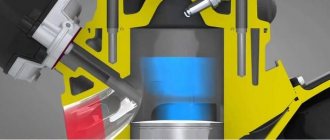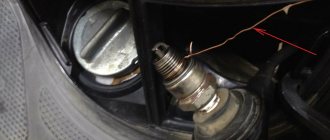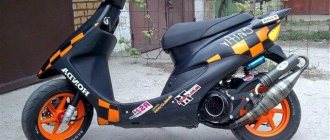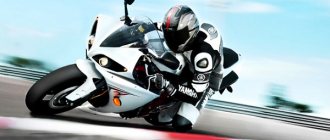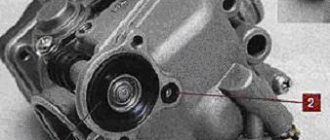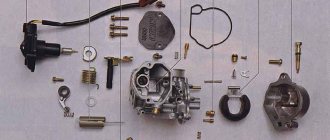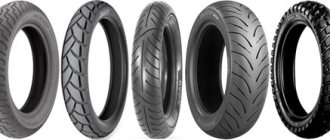MY MOTORCYCLE
The frame is a key part of the motorcycle chassis that links the steering column, engine and rear suspension. The frame can be roughly divided into three parts. The first and mandatory one is the steering column. The front wheel is attached here, and always in such a way that the rider can turn it left and right.
The middle part of the frame, to which the engine, tank and other equipment is attached, may be conditional or even absent. In this case, the motor acts as a load-bearing part.
The rear part of the frame is responsible for mounting the drive wheel. It can be installed rigidly, as on bicycles, using a pendulum or other lever structures. Most motorcycles are equipped with a swingarm rear suspension, so the main task of the rear of the frame is to provide a reliable mounting point for the swingarm. Finally, the rear part of the frame includes a subframe that holds the seat, rear fender, trunk, panniers, your passenger and other useful things.
The frames of modern motorcycles are made of steel and its alloys (a popular material is chromium-molybdenum alloy), aluminum; much less often - carbon, titanium, magnesium. Naturally, the material greatly affects the rigidity, frame weight and overall weight distribution of the motorcycle. The type of frame has an even greater influence on this.
Duplex frame
The oldest design of a motorcycle frame is a duplex frame. It got its name because of two identical rings of strength that begin and end on the steering column and are connected by jumpers. In some places of the frame these rings can be combined. In this case, we are dealing with a half-duplex frame (English: single cradle, half-double cradle). Duplexes and their varieties are simple and cheap to manufacture; the material for them is steel pipes of different sections (extremely rarely - aluminum and its alloys). Such frames cannot be called the ideal of a rigid chassis, which is why they are not used in modern sportbikes and sports tourists. But in cruisers and inexpensive street cars it’s easy. Duplex frames are popular off-road, where it is not rigidity that is important, but the ability of the chassis to absorb shocks and overloads. Duplexes can often be seen on both enduro-tourers and light sports endurics. Recently, cross-country motorcycles have increasingly given preference to aluminum structures. Motorcycles with duplex frames: Yamaha YBR125, Kawasaki W800, Harley-Davidson V-Rod, Yamaha XJR1300, KTM 350 SX-F, BMW G650GS Sertao
Spinal frame
A spine type frame (English: spine, backbone) is not used very often, although it is also simple and inexpensive to manufacture. This is a supporting structure made of profiles in the form of a ridge, to which the power unit is actually suspended, simultaneously taking part of the chassis loads. Backbone frames are usually made of steel. Due to the absence of a lower part in this design, characteristic of duplex frames, its weight can be low, which allows the use of backbone frames even in modern streets, where no one needs extra pounds. They can also be seen in cruisers, enduro-tourers. Backbone frame motorcycles: Honda CB600F Hornet, Honda CB900F Hornet, Confederate R131 Fighter, Yamaha XT1200Z Super Tenere
Diagonal frame
diagonal patterns have become widespread.
frames (
eng. perimeter, beam, diamond, deltabox, twin-spar
). They are based on a pair of metal beams connecting the steering column and the pendulum along the shortest possible line.
Diagonal frames and their varieties (diagonal-spatial) are made mainly from aluminum and its alloys. It happens that steel is used as a material for such frames. Due to their high rigidity and low weight (in the case of the use of aluminum alloys), diagonal frames are widely used in the production of sport bikes, sports tourers and powerful street bikes.
Motorcycles with diagonal frames
: Aprilia RSV4 R, BMW S1000RR, Honda CBR600RR, Kawasaki Z1000, Kawasaki ER-6n/f, Triumph Speed Triple, Yamaha FJR1300
Bird's cage
“Birdcage” (English tubular space, Italian trellis), popular among Italian motorcycle manufacturers, can be considered a type of diagonal frame. Only the basis of the structure here is not a beam, but a section of pipes, steel or aluminum. Traditionally, they are welded to form a lattice structure with triangular sections. A properly welded triangle is an extremely tough thing, which is why “birdcages” are widely used in the production of sports bikes, street bikes and tourists of various profiles. It is believed that the idea of the “birdcage” belongs to the Italian designer Massimo Tamburini, the author of numerous models Bimota, Cagiva, MV Agusta, Ducati. In the production of trellis-type frames, welding culture is important; the companies that have succeeded most in this (besides the above-mentioned ones) are KTM, Moto Morini, Aprilia, Benelli. Recently, aluminum side plates have been added to traditional cages, thereby reducing weight without sacrificing structural rigidity. Birdcage motorcycles: Ducati Monster 696, Ducati Multistrada, Aprilia Dorsoduro 750/1200, KTM 1190 RC8 R, KTM 1190 Adventure, MV Agusta Brutale 675
Monocoque
Frame - monocoque
(
English monocoque
) is considered a rarity in the modern motorcycle industry, although its idea is far from new. This is a spatial structure in which the load-bearing element is the outer shell. The direct expression of a monocoque frame in nature is a chicken egg. We all know that, despite the lightness and small thickness of the shell, the egg is able to withstand heavy loads.
Monocoques were widely used in the early days of aviation in the production of aircraft fuselages. The first two-wheeled vehicle with a motor, built on the basis of a monocoque chassis, was born thanks to aeronautical engineer Corradino D'Ascanio. It was a Vespa scooter, which has been produced for more than 60 years without any major changes in design. In 1967, thanks to the experiment of the Spanish company Ossa, the monocoque came into the world of motorcycles, so far in the form of a Grand Prix prototype. Currently, such frames are also more often used in sports cars than in production motorcycles.
Motorcycles with monocoque frame
: Ducati 1199 Panigale, Kawasaki ZZR1400, Kawasaki 1400GTR
Carrier engine
In most types of frames, the motor takes on part of the load, being more or less load-bearing. A massive crankcase is a very tough thing, and it would be a sin not to use it, saving precious kilograms of the frame. BMW has invented a chassis design in which there is no frame at all. The supporting element of some Bavarian boxer models is the engine block. The front and rear subframes are bolted to the engine, the pendulum with the cardan final drive integrated into it is attached to the engine. It should be recalled that the Germans use Telelever as the front suspension of the R1200R/GS models. It’s hard to say whether they could install a classic steering column without the mediation of the frame. Motorcycles with a monocoque engine: BMW R1200R, BMW R1200GS (until 2013)
Features of choosing a bicycle according to technical characteristics
To choose a high-quality model, you should pay attention to the following data:
Frame. The weight of the vehicle will depend on the size and material from which it is made. The smaller and lighter the frame structure, the more accurate the controls will be.
Steel frames can be divided into:
- improved quality. Cheaper, but heavier in weight.
- chromium-molybdenum It is characterized by high strength and lightness. Suitable for beginners.
Aluminum versions are lighter and stiffer. They allow you to accelerate and go up hills, but this version will last less than the steel version.
For professionals and experienced racers, titanium and carbon ones are used. They have low impact resistance and lightness. They allow you to perform tricks and gain high speed.
Shock absorber. In order for the bike to last for many years and be comfortable, special attention should be paid to the shock absorber.
It should provide good softness, smoothness, and remove the load from the hands. If you have an aluminum frame, you can’t do without a high-quality shock absorber, as aluminum alloys do not make vibrations weaker and break under heavy shaking.
Switching speeds. The gearbox must be of high quality, or it will have to be repaired very soon. Products from Shimano and SRAM are considered durable.
Brakes. Safety depends primarily on how good the braking system is. There are several variations:
- Rims are found in budget models and are not intended for heavy trails. Lightweight and simple in design. Do not use in rainy weather and do not allow dirt to enter.
- Mechanical disc brakes are expensive, but they allow you to drive in any weather and perform smooth and safe braking. But they have a heavy structure and are difficult to repair.
- Hydraulic disc ones are the most elite and expensive. With their help you can brake slowly and sharply. Suitable for any weather and used by professionals.
Wheels. In the production of bicycles, variations with a diameter from 20 to 29 inches are used:
- 20 inches - for children's models,
- 24 - for teenage and old copies,
- 26 - for pleasure bikes,
- 28 - for urban, tourist types,
- 29 - for mountain specimens.
The cross-country ability and speed capabilities of the bike depend on the diameter. With larger ones it is possible to cover long distances in less time. But more energy will be spent. From this it turns out that it is easier to gain speed on wheels of small diameter than on large ones.
Steering system. Aluminum versions are considered the most popular and high-quality. Also a nice addition will be the function of adjustable stem and lift of the steering wheel.
Varieties:
- Mountain: for driving through places without roads.
- Vertical: installed on hybrid versions.
- Ram's horns: installed on road and touring models.
- Butterfly.
- Mustache.
- Cowhorn: Suitable for racing and racing.
Types of bicycle frames
Initially, bicycle frames are divided into male and female types. Women's models are available with or without a lowered top tube.
Women's types of bicycle frames are designed taking into account the physiological characteristics of the body and are the most comfortable for a cyclist.
Depending on the purpose and operational features, bicycle frames are divided into off-road, road and tandem models.
Types of bicycle frames:
- Off-road bicycle frames
- Hardtail.
Manufactured without rear suspension, designed for MTV (mountain bike), not equipped with rear triangle shock absorbers. There are places for luggage.
Soft tail.
For off-road vehicles with two shock absorbers. Optimal on rough roads, but not designed for jumping.
Double suspension designs with rear shock absorber.
Designed for extreme riding, but the model does not provide places for attaching luggage.
Tandem SUV model.
Frame with the ability to use wide tires and shock absorber forks.
Velorama for road bikes
- A classic model of a city bike bicycle frame with places for attaching luggage and a basket.
Features a vertically mounted saddle.
Highway frame.
It has excellent aerodynamic characteristics, dynamic roll-up, and is suitable for low landing positions, but there is no place for attaching luggage.
Rigid.
Velor frame for bike models without shock absorber. This bike is intended only for hard riding on flat surfaces.
Cyclocross
For maneuverable riding on rough terrain.
Touring
For long tourist bike trips, it optimally combines comfort and streamlining. The touring car can be equipped with two racks.
Tandem models.
Designed for simultaneous pedaling of two cyclists.
In addition to well-known designs, there are types of bicycle frames in shape suitable for professional extreme sports: league, trial.
Technologies
In the production of two-wheeled vehicles, Giant widely uses its own advanced technologies, aimed primarily at the efficiency of finished bikes, including:
- Advanced Composite Technology - creating frames using high-level carbon fiber, allowing for low weight and excellent rigidity of the final product.
- Advanced Composite SL Technology produces professional grade carbon fiber frames using modern design and engineering techniques.
- Advanced Forged Composite Technology is a modern process for manufacturing complex bicycle components (such as rear suspension components) from carbon fiber using high-pressure molds.
- ALUXX Aluminum Technology is a high-level aluminum production technology for strong and lightweight frames with variable tube cross-sections.
- ALUXX SL/SLR Aluminum Technology is a technology for manufacturing high-level aluminum frames using unique welding processes.
- AeroSystem Shaping Technology is a process that optimizes the shape of each frame, thereby ensuring a low level of aerodynamic drag in the finished bike.
- D-Fuse Technology is a technology for manufacturing handlebars and saddles that provide the rider with the maximum level of comfort and absorb road shocks and vibrations.
- Hybrid Cycling Technology is a system for creating powerful and efficient electric bikes equipped with modern electric motors and Giant batteries.
- Maestro Suspension Technology is an innovative rear suspension with four strategically placed fulcrum points and a floating axle that improves pedaling efficiency and keeps the rear wheel in constant contact with the ground (even under heavy braking).
- OverDrive/OverDrive 2 – modern technologies for creating steering units for Giant bicycles.
Position
If the saddle height is universal for all types of bicycles, then its position may differ.
Top articles: What is the maximum speed you can reach on a bicycle?
First, let's discuss the angle of inclination. For normal riding, it is better to use a horizontal saddle position.
This is especially true for men, since due to physiology, tilting the seat can cut off blood circulation and pinch important organs.
If we talk about the types of seats, there are special saddles for men with a notch in the central part. They are usually narrower than the women's versions. Therefore, take this factor into account when choosing a bike.
It is better to purchase a comfortable seat separately from the iron horse.
If you are going uphill, it is better to tilt the seat with the front part down. This will provide a more comfortable climb and reduce energy loss. When performing tricks, the saddle must be tilted back.
Many modern seats have rails in their design, with which the saddle can be moved in a horizontal plane.
Before determining the optimal reach, it is necessary to understand the peculiarities of the cyclist’s seating position on various types of bikes.
On mountain bikes, the rider's body must be tilted at 45 degrees, while on road bikes, the rider "lays" the body almost 90 degrees.
This is important to consider when adjusting the seat reach. A comfortable driving position is ensured by a combination of handlebar and seat adjustments, so don't be content with just adjusting the saddle
It is important to remember that if the seat is pushed back too far, the weight will shift towards the rear wheel. This shift in the center of gravity unloads the front shock absorber and can create the likelihood of an accident or rollover.
This shift in the center of gravity unloads the front shock absorber and can create the risk of an accident or rollover.
And too close a position will cause inconvenience when rotating the pedals. In addition, in both cases you will experience discomfort in your shoulders, neck and back.
Therefore, adjust the reach wisely, based on your height, shape and riding characteristics.
Experiment! Set your saddle position and ride a few times. If you feel uncomfortable, keep changing the settings.
As mentioned above, by combining handlebar and saddle settings, we achieve the optimal riding position for the cyclist. And depending on the type of bike it can be different.
Handlebar height
The comfort and efficiency of shock absorbers depends on the height of the steering wheel. If the handlebars are too high, the cyclist will sit almost upright.
This will shift the center of gravity toward the saddle and reduce the load on the handlebars, which will reduce the effectiveness of the front shock absorber. Although for beginners it is better to raise the steering wheel slightly above the seat level.
On city bikes, the handlebars are located at the same level as the saddle, while on road bikes the handlebar height is lower. This is due to the position of the rider's torso when riding.
The almost 90-degree tilt, which provides low air resistance and high speed, is achieved through the correct combination of handlebar and saddle level.
The main rule for mountain bikes is that the rider's arms are bent at approximately 45 degrees at the elbows.
This will ensure effective operation of the shock absorbers and reduce discomfort from vibrations transmitted to the hands.
Tires
Tires come in different sizes. For example, size 26x1.95 means that it is for a 26-inch wheel and has a width of 1.95 inches. Mountain bikes are equipped with fairly wide tires from 1.8 inches. The wider the tire, the more comfortable it is to ride over uneven roads. I recommend a width of at least 2.1, and preferably 2.25. But the wider the tires, the more expensive they are.
For road bicycles, the tire size is indicated according to the same principle, but in millimeters, for example 700x25 (700 mm - diameter, 25 mm - width). The narrower the tire, the faster the bike and the worse the handling and comfort.
There are different types of tires based on their tread pattern, the main ones being slick, semi-slick and mud tires.
Slick is an almost completely smooth rubber with small drainage grooves. Designed for fast driving on perfectly flat surfaces. Mainly used on road bikes.
Mud tires are a more versatile option, allowing you to move comfortably both off-road and on asphalt. Usually installed on mountain bikes. On smooth asphalt, the driving performance is inferior to slicks and semi-slicks, but for us, good asphalt is a luxury. There are universal models of mud tires that ride well on any surface (a more aggressive analogue of semi-slicks), for example the Schwalbe Smart Sam.
Semi-slick is a cross between slicks and mud tires.
Tires vary greatly in quality. The cheapest ones I had became unusable after 2-3 thousand kilometers, and the same Smart Sam lasted 10,000 km. Although they are much more expensive, it is definitely justified. And not only in terms of mileage, but also in how they handle the road. If you recommend any companies, then some of the best bicycle tires are made by Schwalbe and Continental.
- 1
- 2
- 3
- 4
- 5
Top articles: How to adjust the handlebars on a bicycle
Steel frames
There are two types of steel bicycle frames:
- made of carbon steel – a budget material that is not of the best quality. As a rule, bicycles for children are made from it. Remember how often in a store you came across the fact that a children’s bike weighed the same as yours? The option is not the most convenient, but it is reliable;
- their chrome-molybdenum steel - the alloy is considered one of the most progressive today. This material is actively used in the production of classic road bikes and some models of bikes for extreme riding. In most cases, chrome-molybdenum frames are produced using butted technology. Its essence lies in differentiating the wall thickness of the tubes used in assembling the frame structure. This technique allows you to significantly reduce the weight of the part without losing reliability.
Advantages and disadvantages of steel frames
Speaking about the strengths of steel frames, it is worth noting the following nuances:
- Bicycles with a steel base have excellent rolling properties. Therefore, cyclists can safely pause, stop pedaling, and be confident that the frame will maintain its speed.
- The steel structure perfectly absorbs vibrations and absorbs shock, so the ride is soft and comfortable.
- The soft bend of the frame will come in handy when cornering.
- Steel is a durable, reliable material with a long service life.
- If necessary, you can repair the frame yourself by welding small cracks in a garage.
As for the shortcomings, here you should pay attention to:
- Susceptibility of metal to corrosive processes, rust.
- High density of the material, which makes the steel structure quite heavy. Most often, cyclists refuse steel bikes precisely because of their heavy weight.
- Inefficient distribution of energy during pedaling, which leads to reduced acceleration.
Touring (touring, tourist bike)
If a hybrid is a step towards a more versatile mountain bike, then a touring
is a step towards an all-round bike from a road bike. This bike is designed for long cycling trips at a fast pace, but with the ability to ride both on good highways and, if necessary, on average roads.
The overall layout of a touring bike is similar to that of a road bike, but the high-quality chrome-moly steel frame is usually longer, which improves ride quality and dampens vibrations, and is designed to accommodate additional equipment.
A touring bike differs from a road bike in having stronger wheels and wider tires. Another difference is the increased gear range: usually the cassette and rear derailleur are taken from a mountain bike, and the rest of the drive hardware is from a road or hybrid bike.
The ability to install guards and a rack makes this bike suitable for cycling with a load. The bike is better suited to fast highway travel than a hybrid, but is less dependent on road conditions than a road bike.
Fuji, Trek, Kona assemble only 1-2 models each
and
Cannondale
.
Who will need the frame?
Knowing what a “frame car” means, we can easily draw a conclusion about the purpose of such vehicles. They are suitable for use as commercial vehicles, as well as special vehicles designed to perform very heavy work. In addition, an SUV that is not designed to overcome city curbs also needs a frame.
If you definitely don’t need such cars, you should pay closer attention to modern cars with a monocoque body. They offer greater fuel efficiency, as well as safety and practicality.
Types of bicycles and their choice
There are quite a few classifications of bicycles. They are mainly divided:
- by age of the consumer (children, teenagers, adults);
- by gender (for boys, for girls, male, female, unisex);
- by purpose (urban, mountain, BMX, folding, road and others).
In this article we will look at buying a bicycle for an adult using a mountain bike as an example, since this type is now the most popular and versatile on the market.
Before we move directly to our main topic, I would like to give some advice to potential buyers, since I am an employee of one of the largest sports retailers in Europe, I have been selling sports equipment for more than five years, and I have something to share with you.
My first advice is that if this is your first purchase of a bicycle, and you do not yet know what frame size you need, be sure to come to the store yourself, try to sit and ride the model you are interested in, under no circumstances buy online and do not send your relatives or friends for shopping. Why? Yes, you can look at the size chart for bicycles on the Internet and roughly understand what size we need, but in fact, height does not fully guarantee that you will be comfortable. Each person has different body proportions, the legs can be shorter than the body, or they can be longer than it, and in both cases, the riding position of two people of the same height, but different proportions, will be completely different. For example, it may turn out that one buyer with a height of 178 cm may be suitable for the 20th frame, while for another only the 18th. Therefore, you need to understand that it is you who ride a bicycle, and not your relatives or friends, so do not rush to shift the responsibility for the purchase to someone else. Moreover, according to the consumer protection law, a bicycle is a complex technical product, so any retailer has the right to refuse to return the product to you.
The second piece of advice I will give is to prepare and collect information about the models you are interested in. If, after collecting information, it becomes clear to you approximately what kind of bike you need (frame material, type of shifters, brakes, rims, wheel size, etc.), this will greatly facilitate the buying process, you will know what you want, and the seller will show only a few models according to your requests, and will not tell you from scratch about all the nuances and differences. As a last resort, if you don’t have the opportunity to devote at least a little time to theory and search for information on the Internet, you can safely take cyclist friends with you, everyone will have at least one of them. However, those who read this article to the end most likely will not need to look for any additional information anywhere.

